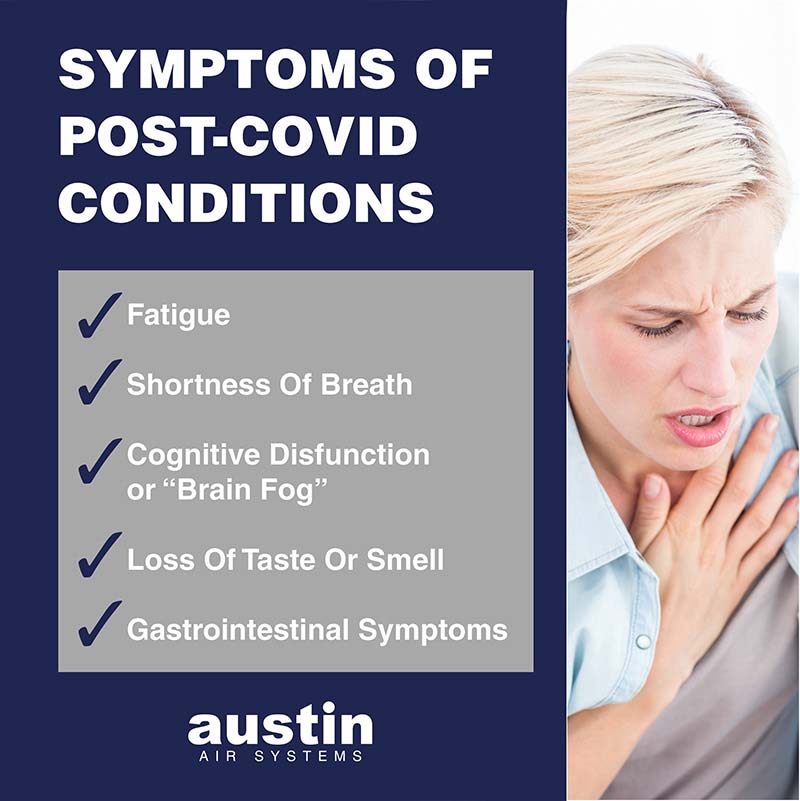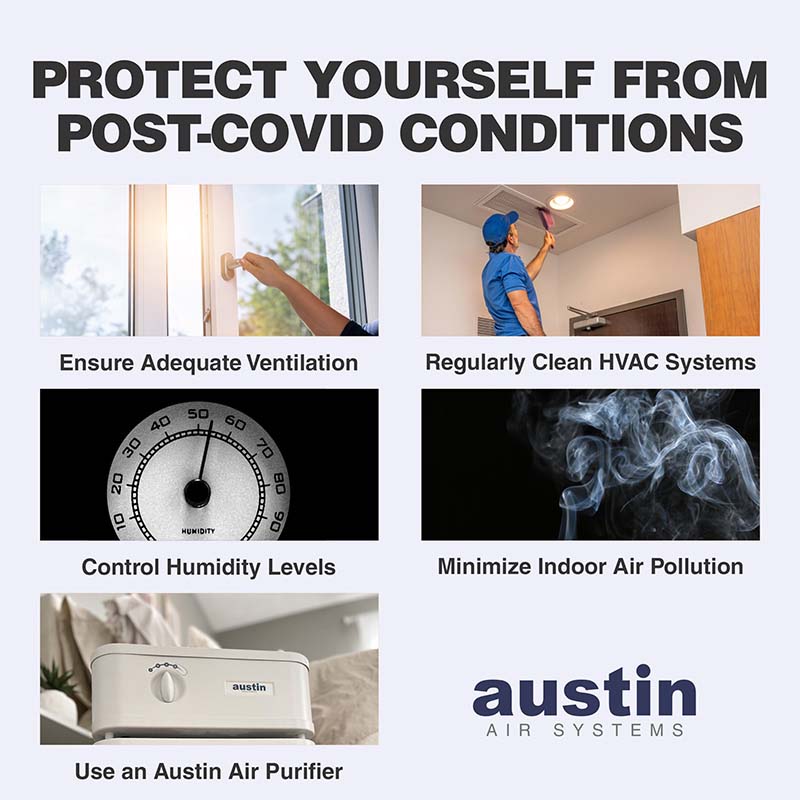Long-haul COVID is the phenomenon where people continue to experience persistent symptoms – or develop new symptoms – for four weeks or longer after the fever, cough, etc. of the acute phase of COVID-19 have resolved.1
It has many names: long COVID, post-acute COVID-19, long-term effects of COVID, chronic COVID, post-acute sequelae of SARS-CoV-2 infection (PASC), and post-acute COVID-19 syndrome (PACS). The umbrella term for all of these is post-COVID conditions (PCC). PCCs can range in severity from mild to debilitating.
There is still much to learn about PCCs, and researchers are trying their best to pinpoint the causes and find treatments. Two recent studies have shown a direct link between exposure to ambient air pollution and the development of long COVID – making indoor air quality measures additionally urgent as COVID becomes endemic or regularly occurring.
The Symptoms of Post-COVID Conditions
PCCs are alarming because they cause functional impairment that poses significant obstacles to well-being and overall quality of life. They can involve multiple organ systems for various physical, social, and psychological effects. New symptoms may emerge over time, and the severity and duration of symptoms can fluctuate. There is a laundry list of commonly reported symptoms of Long COVID, and sufferers usually have a combination of problems.
Fatigue, Lightheadedness, and Poor Endurance: One of the leading challenges for people with long-term COVID is persistent exhaustion or lack of energy, which can interfere with daily activities and quality of life.
Shortness of Breath or Labored Breathing: Difficulty breathing (dyspnea) or a feeling of breathlessness, even during mild physical exertion. A chronic cough is also a common issue.
Cognitive Dysfunction (“Brain Fog”): Difficulty concentrating, memory problems, and impaired cognitive function, which can affect work, school, and daily tasks.
Joint and Muscle Pain: Persistent or recurring pain in the joints (arthralgia) and muscles (myalgia), which may be accompanied by stiffness or weakness.
Chest Pain: Discomfort or tightness in the chest, which may be sharp or dull in nature.
Headaches: Recurring headaches or migraines, varying in intensity and duration.
Heart Palpitations: Sensations of irregular or rapid heartbeat, which may be accompanied by dizziness or lightheadedness.
Loss of Taste or Smell: Persistent or recurring loss of taste (ageusia) or smell (anosmia), which can impact appetite and enjoyment of food.
Gastrointestinal Symptoms: Symptoms such as nausea, vomiting, diarrhea, or abdominal pain, which may occur independently or in conjunction with other symptoms.
Insomnia or Sleep Disturbances: Difficulty falling asleep, staying asleep, or experiencing restful sleep, leading to fatigue and daytime drowsiness.
Mood Changes: Anxiety, depression, mood swings, or irritability, which impact mental well-being and social functioning.2
Skin Rashes: Persistent or recurring skin rashes, hives, or lesions that are itchy or uncomfortable.
That’s quite the list because every individual’s experience with Long COVID is unique, and there is no one-size-fits-all situation.
How can someone avoid PCCs now that COVID is a regular part of cold and flu season? Well, some good news is that there is evidence that good indoor air quality can help – or instead, evidence shows that long-term exposure to bad air quality increases the risk of developing long COVID.

Long COVID in Young Adults Exposed to Ambient Air Pollution in Sweden
The public health implications of long-haul COVID are huge. In fact, some experts and agencies are linking the worker shortage to severe long COVID removing people from the workforce. There are reports of long COVID sufferers staying out of work for more than a year.3
Because little is known about the risk factors for developing PCCs, researchers investigated any possible link between exposure to air pollution – a potentially common risk factor for many people – and the development of Long COVID in Swedish young adults.4
They defined long COVID as any symptoms persisting for two months or longer after the initial infection of COVID-19. Data was utilized from the BAMSE Project (Children, Allergy, Environment, Stockholm, Epidemiology [in Swedish]) from the Institute of Environmental Medicine. Participants filled out surveys about their symptoms from October 2021 to February 2022.
Additionally, levels of common air pollutants like particulate matter 2.5 (PM2.5), black carbon (BC), and nitrogen oxides (NOx) were estimated using dispersion modeling – a method that tracks pollutants from their source with weather factors included.5
Of the participants who reported symptoms of long COVID, the most prevalent symptoms were fatigue (4.5%), difficulty breathing (4.8%), and lost or weakened taste and smell (10.6%). Those who were exposed to higher levels of ambient PM2.5 were more likely to experience long COVID symptoms. Researchers also found that asthmatics were more likely to have lingering COVID issues.
The results led researchers to conclude that long-term environmental exposure to PM2.5 could increase the risk of long COVID in young adults – a population that isn’t generally predisposed to health issues like seniors – and therefore, supports “efforts for continuously improving air quality.”
Ambient Air Pollution and Long COVID Symptoms in Saudi Arabia
Roughly 4,000 miles away from Stockholm in the Makkah (or Mecca) region of Saudi Arabia, another group of researchers examined the issue of exposure to ambient air pollution and the development of long-term COVID. The authors of this study wanted to build on previous research showing that air pollution, specifically particulate matter (PM 2.5 and PM10), could extend the length of a COVID-19 infection by looking for a link to long COVID.67
The participants contracted COVID between 2022 and 2023 and were tasked with completing a thorough questionnaire. The information included “detailed demographic data” and questions assessing any symptoms they experienced post-COVID. Air sampling was conducted throughout the Makkah area for over a year to establish the PM levels.
Perhaps unsurprisingly: “Significant positive associations were found between PM2.5 and PM10 exposure and long COVID.” Analysis of specific symptoms showed a strong link between PM2.5 exposure and shortness of breath.
Ultimately, the authors concluded that reducing ambient air pollution is necessary to prevent lingering COVID-19 symptoms.
Protect Yourself from Post-Covid Conditions
It’s not difficult to guess why two different groups of scientists chose to examine the issue of air quality and lingering COVID-19 symptoms – both issues plague nearly every part of the planet.
Outdoor air pollution can impact indoor air quality (IAQ) by entering structures through doors and windows. There are also indoor factors that lower IAQ, like gas stoves. It’s crucial to improve IAQ to mitigate potential risks during the acute phase of COVID-19 and to prevent long-term health issues. Steps you can take include:
- Ensuring adequate ventilation by opening windows or using mechanical ventilation systems.
- Regularly maintain and clean HVAC systems to prevent the buildup of contaminants.
- Controlling humidity levels to prevent mold growth and maintain comfort.
- Minimizing sources of indoor air pollution, such as smoking indoors and using harsh cleaning products. Keeping indoor spaces clean and free of dust, pet dander, and other allergens.
- Using air purifiers with HEPA filters and activated carbon to remove airborne particles and pollutants.
Addressing IAQ may not directly treat long COVID if it does rear its ugly head, but it can contribute to overall respiratory health and potentially alleviate symptoms or improve comfort for individuals with long-term COVID-19 symptoms.
For now, we’ll be following as research continues on the relationship between indoor air quality and long-haul COVID-19. Stay safe out there!

REFERENCES
1 Post-COVID Conditions: Information for Healthcare Workers. (2023, September 11). Centers for Disease Control and Prevention. https://www.cdc.gov/coronavirus/2019-ncov/hcp/clinical-care/post-covid-conditions.html.
2 Understanding the link between long COVID and mental health conditions. (2023, August 17). American Heart Association. https://www.heart.org/en/news/2023/08/17/understanding-the-link-between-long-covid-and-mental-health-conditions.
3 New York State Insurance Fund. (2023) Shining A Light On Long Covid: An Analysis Of Workers’ Compensation Data. https://ww3.nysif.com/-/media/Files/NYSIF_Publications/PDF/NYSIFLongCOVIDStudy2023.ashx.
4 Yu Z, Ekström S, Bellander T, et al. Ambient air pollution exposure linked to long COVID among young adults: a nested survey in a population-based cohort in Sweden. Lancet Reg Health Eur. 2023 May;28:100608. doi: 10.1016/j.lanepe.2023.100608.
5 Air Quality Dispersion Modeling (2023, December 13). US EPA. https://www.epa.gov/scram/air-quality-dispersion-modeling.
6 Ali N, Fariha KA, Islam F, et al. Exposure to air pollution and COVID-19 severity: A review of current insights, management, and challenges. Integr Environ Assess Manag. 2021 Nov;17(6):1114-1122. doi: 10.1002/ieam.4435.
7 Saleh SAK, Adly HM. Impact of Ambient Air Pollution Exposure on Long COVID-19 Symptoms: A Cohort Study within the Saudi Arabian Population. Infect Dis Rep. 2023 Oct 19;15(5):642-661. doi: 10.3390/idr15050060.
